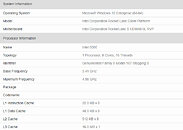Monday, July 27th 2020

Intel to Clock "Rocket Lake-S" High, Evidence of an ES with 5.00 GHz Boost
Intel's 11th Generation Core "Rocket Lake-S" desktop processors in the LGA1200 package could come with clock speeds that are of the norm these days. Intel appears unwilling to dial down clock speeds in the wake of increased IPC with the new generation "Cypress Cove" CPU cores that drive these processors. Twitter handle "leakbench," which tracks interesting Geekbench results, fished out a database listing for a "Rocket Lake-S" engineering sample with clock speeds of 3.40 GHz base, and 5.00 GHz boost.
The listing has all the telltale signs of "Cypress Cove," such as 48 KB L1D cache, 512 KB per core L2 cache, and 16 MB shared L3 cache for this 8-core/16-thread chip. "Cypress Cove" is rumored to be to be a back-port of Intel's "Willow Cove" CPU core design from its original 10 nm+ node to the 14 nm++. VideoCardz compared this "Rocket Lake-S" ES benchmark result to that of a retail Core i7-10700K, and found its single-threaded performance to be roughly 6.35 percent higher despite a 200 MHz clock-speed deficit, although for some reason, its multi-threaded performance is trailing by over 15 percent.
Sources:
Geekbench Database, Leakbench, VideoCardz, HardwareLeaks
The listing has all the telltale signs of "Cypress Cove," such as 48 KB L1D cache, 512 KB per core L2 cache, and 16 MB shared L3 cache for this 8-core/16-thread chip. "Cypress Cove" is rumored to be to be a back-port of Intel's "Willow Cove" CPU core design from its original 10 nm+ node to the 14 nm++. VideoCardz compared this "Rocket Lake-S" ES benchmark result to that of a retail Core i7-10700K, and found its single-threaded performance to be roughly 6.35 percent higher despite a 200 MHz clock-speed deficit, although for some reason, its multi-threaded performance is trailing by over 15 percent.

33 Comments on Intel to Clock "Rocket Lake-S" High, Evidence of an ES with 5.00 GHz Boost
I always buy the igpu versions cause where else are you going to get emergency situation display for just a couple of bucks but if Xe igpu could actually play less demanding titles at 1080p low then it'd be sweet.
I'll be dumping my 2070S soon before rtx3000 and that means no gaming for a few weeks.With a,let's say 1050,level gpu I could still play some stuff
If you take either Intel or AMD and put typical $50 air-cooling on a mid-tier motherboard, and then give it a medium load (like gaming or multitasking between a Suite/Browser/Voice) then you'll find that R9 is running around 4.2GHz and i9 is running around 4.6GHz. Don't forget, that's with cooling and a board that already exceeds the 'stock' values, given how motherboard vendors like to squeeze for a competitive advantage.
Sure, they can both hit 500MHz higher on a single core, but when was the last time your OS actually paused all background threads, outside of a synthetic benchmark that artificially grabs all cores and parks all of them except the one running the single-threaded test? If you actually want the advertised boost clocks for either platform across all cores, you are going to need a herculean motherboard, some impressive cooling and plenty of OC experience to dial the voltages down before your socket melts.
Please don't tell me that "10%" came from Moore's Law is Dead.
That said, Willow Cove is supposed to feature more/updated L3 as its headlining feature. All the leaks around Cypress Cove show that the 8-core ES has exactly the same amount of L3 as existing 8-core SKUs from Coffee 8-core and Comet 10-core dies. Intel did say it was a "reworked cache structure"...
Locked skus like 10700 are the best all round propositions in the 10 series,but you dont know about that,as was clear in the previous thread that you spammed not even realizing 10700 was an 8/16
Intel grasping at straws to try and relive their glory days when they could boast about how much faster clock speeds their CPUs had over AMD offerings.
a 32 ncu/sm navi/turing would be very fast. 2060 super/5700 level.